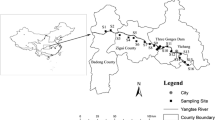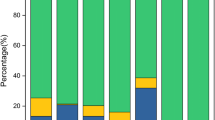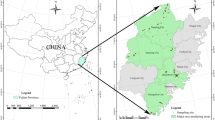Abstract
Modern Yellow River Delta (MYRD) is a typical petrochemical and agricultural industrial area of China. To effectively assess the current status of the four heavy metals (Cr, Pb, Ni and Cd) of topsoil residues, soil samples (0 ~ 20 cm) (n = 104) in the MYRD were collected and analyzed. The results showed that the contents of the four heavy metals were all below or equal to the level 1 background content as specified in the National Environmental Quality Standard for Soils, while the content of Cd and Pb were 1.68 and 1.41 times higher than the background value of soil in Shandong province, respectively. The difference of four heavy metal contents between different kinds of land types existed. Geoaccumulation index and potential ecological risk index methods were used to evaluate the risk of the four heavy metal pollution in the MYRD. The results showed that there was a light or moderate pollution of heavy metals Cd and Pb, which were a strong ecological hazard. Therefore, it is necessary to enhance the monitoring and controlling of heavy metal Cd and Pb pollution in the MYRD.



Similar content being viewed by others
Data Availability
All data generated or analysed during this study are included in this published article.
References
Ackah M (2019) Soil elemental concentrations, geoaccumulation index, non-carcinogenic and carcinogenic risks in functional areas of an informal e-waste recycling area in Accra, Ghana. Chemosphere 235:908–917
Arrebola JP, Ramos JJ, Bartolomé M, Esteban M, Huetos O, Cañas AI, Herranz AL, Calvo E, Pérez-Gómez B, Castaño A (2019) Associations of multiple exposures to persistent toxic substances with the risk of hyperuricemia and subclinical uric acid levels in bioambient.es study. Environment International 123:512–521
Azzi DE, Probst JL, Teisserenc R, Merlina G, Baqué D, Julien F, Payre-Suc V, Guiresse M (2016) Trace element and pesticide dynamics during a flood event in the save agricultural watershed: soil-river transfer pathways and controlling factors. Water, Air, & Soil Pollution 227: 442(1-19)
Bai JH, Jia J, Zhang GL, Zhao QQ, Lu QQ, Cui BS, Liu XH (2016) Spatial and temporal dynamics of heavy metal pollution and source identification in sediment cores from the short-term flooding riparian wetlands in a Chinese delta. Environmental Pollution 219:379–388
Bai JH, Zhao QQ, Wang W, Wang X, Jia J, Cui BS, Liu XH (2019) Arsenic and heavy metals pollution along a salinity gradient in drained coastal wetland soils: depth distributions, sources and toxic risks. Ecological Indicators 96:91–98
Bazilevskaya E, Rother G, Mildner DF, Pavich M, Cole D, Bhatt MP et al (2015) How oxidation and dissolution in diabase and granite control porosity duringweathering. Soil Science Society of America Journal 79(1):55–73
Cui B, Yang Q, Yang Z, Zhang K (2009) Evaluating the ecological performance of wetland restoration in the Yellow River Delta, China. Ecological Engineering 35(7):1090–1103
Duong TT, Lee BK (2011) Determining contaminationlevel of heavy metals in road dust from busy traffic areaswith different characteristics. Journal of Environmental Management 92(3):554–562
Feng Y, Chenglin L, Bowen W (2019) Evaluation of heavy metal pollution in the sediment of Poyang Lake based on stochastic geo-accumulation model (SGM). Science of the Total Environment 659:1–6
Förstner U, Wittmann GTW, Prosi F et al (1979) Metal pollution in the aquatic environment[M]. Springer Verlag, Berlin
Gan HY, Liang K, Zheng ZC (2010) Backgroundvalues, contamination assessment and zoning of heavy metals in sediments of the Pearl River estuary. Earth and Environment 38(3):344–350
Guo H, Yang L, Han X, Dai J, Pang X, Ren M, Zhang W (2019) Distribution characteristics of heavy metals in surface soils from the western area of Nansi Lake, China. Environmental Monitoring and Assessment 191:262(1–13)
Hakanson L (1980) An ecological risk index for aquatic pollutioncontrol. A sedimentological approach. Water Research 14(8):975–1001
Hu N, Shi X, Liu J, Huang P, Yang G, Liu Y (2011) Distributions and impacts of heavy metals in the surface sediments of the Laizhou Bay. Advances in Marine Science 29:63–72
Hu B, Wang J, Jin B, Li Y, Shi Z (2017) Assessment of the potential health risks of heavy metals in soils in a coastal industrial region of the Yangtze River Delta. Environmental Science and Pollution Research International 24(24):19816–19826
Hua Y, Cui B, He W (2012) Changes in water birds habitat suitability following wetland restoration in theYellow River Delta, China. CLEAN–Soil, Air, Water 40(10):1076–1084
Jaishankar M, Tseten T, Anbalagan N, Mathew BB, Beeregowda KN (2014) Toxicity, mechanism andhealth effects of some heavy metals. Interdisciplinary Toxicology 7(2):60–72
Javed M, Ahmad I, Usmani N, Ahmad M (2016) Studieson biomarkers of oxidative stress and associated genotoxicity and histopathology in Channa punctatus from heavy metal polluted canal. Chemosphere 151:210–219
Kong WL, Wang S, Ye-Long DU, Wan Q, ShuangYing LI (2011) Composition and geochemistry of Permian clastic rocks in the northern margin of the middle and upper Yangtze region. Geochimica (Beijing) 40(5):473–486
Lai TM, Lee W, Hur J, Kim Y, Huh IA, Shin HS, Kim CK, Lee JH (2013) Influence of sediment grain size and land use on the distributions of heavy metals in sediments of the Han River basin in Korea and the assessment of anthropogenic pollution. Water, Air, and Soil Pollution 224(7): 1609(1-12)
Li M, Yang W, Sun T, Jin Y (2016) Potential ecological risk of heavy metal contamination in sediments and macrobenthos in coastal wetlands induced by freshwater releases: a case study in the Yellow River Delta, China. Marine Pollution Bulletin 103(1–2):227–239
Li YF, Zhao ZQ, Yuan Y, Zhu PT, Li XZ, Guo AN, Yang Q (2019) Application of modified receptor model for soil heavy metal sources apportionment: a case study of an industrial city, China. Environmental Science and Pollution Research 26(16):16345–16354
Liu X, Qi S (2011) Wetlands environmental degradation in the Yellow River Delta. Shandong Province of China, Procedia Environmental Sciences 11:701–705
Long Q, Wang J, Da L (2013) Assessing the spatial–temporal variations of heavy metals in farmland soil of Shanghai, China. Fresenius Environmental Bulletin 22(3):928–938
Lu RK (1999) Analytical methods for soil and agro-chemistry. China Agricultural Science and Technology Press, Beijing, pp 1–638
Muller G (1979) Schwermetalle in den sediments des Rheins-Veranderungen seitt 1971. Umschan 79:778–783
Murati E, Hristovski S, Melovski L, Karadelev M (2015) Heavy metals content in Amanita pantherina in avicinity of the thermo-electric power plant Oslomej, republic of Macedonia. Fresenius Environmental Bulletin 24(5):1981–1984
Pan F, Yu Y, Yu L, Lin HL, Wang YY, Zhang LL, Pan DW, Zhu RL (2020) Quantitative assessment on soil concentration of heavy metal–contaminated soil with various sample pretreatment techniques and detection methods. Environmental Monitoring and Assessment 192:800 (1-8)
Santschi PH, Presley BJ, Wade TL, Garcia-Romero B, Baskaran M (2001) Historical contamination of PAHs, PCBs, DDTs, and heavy metals in Mississippi river Delta, Galveston bay and Tampa bay sediment cores. Marine Environmental Research 52(1):51–79
Shi C, Ding H, Zan Q, Li R (2019) Spatial variation and ecological risk assessment of heavy metals in mangrove sediments across China. Marine Pollution Bulletin 143:115–124
Teixeira RA, Souza ES, Lima MW, Dias YN, Silveira Pereira WV, Fernandes AR (2019) Index of geoaccumulation and spatial distribution of potentially toxic elements in the Serra Pelada gold mine. Journal of Soils and Sediments 19(7):2934–2945
Wang FY, Liu RJ, Lin XG, Zhou JM (2004) Arbuscular mycorrhizal status of wild plants in saline-alkaline soils of the Yellow River Delta. Mycorrhiza 14(2):133–137
Wang Y, Wang R, Fan L, Chen T, Bai Y, Yu Q, Liu Y (2017) Assessment of multiple exposure to chemical elementsand health risks among residents near Huodehonglead-zinc mining area in Yunnan, Southwest China. Chemosphere 174:613–627
Xie Z, Sun Z, Zhang H, Zhai J (2014) Contamination assessment of arsenic and heavy metals in a typical abandoned estuary wetland—a case study of the Yellow River Delta natural reserve. Environmental Monitoring and Assessment 186(11):7211–7232
Yang H, Sun J, Song A, Qu F, Dong L, Fu Z (2017) A probe into the contents and spatial distribution characteristics of available heavy metals in the soil of Shell Ridge Island of Yellow River Delta by means of ICP-OES method. Spectroscopy and Spectral Analysis 37(4):1307–1313
Yao X, Xiao R, Ma Z, Xie Y, Zhang M, Yu F (2016) Distribution and contamination assessment of heavy metalsin soils from tidal flat, oil exploitation zone and restored wetland in the Yellow River estuary. Wetlands 36(1):153–165
Yao C, Jiang X, Che F, Wang K, Zhao L (2019) Antimony speciation and potential ecological risk of metal(loid)s in plain wetlands in the lower Yangtze River valley, China. Chemosphere 218:1114–1121
Yuncu B, Sanin FD, Yetis U (2006) An investigation of heavy metal biosorption in relation to C/N ratio of activated sludge. Journal of Hazardous Materials B 137:990–997
Zhang GL, Bai JH, Zhao QQ, Lu Q, Jia J, Wen X (2016) Heavy metals in wetland soils along a wetland-forming chronosequence in the Yellow River Delta of China: levels, sources and toxic risks. Ecological Indicators 69:331–339
Zhang B, Yin L, Zhang S, Feng C (2016a) Assessment on characteristics of LUCC process based on complex network in modern Yellow River Delta, Shandong Province of China. Earth Science Informatics 9:83–93
Zhang L, Chen P, Jian LI, Chen X, Feng Y (2016b) Distribution of soil salt ions around Tamarix chinensis individuals in the Yellow River Delta. Acta Ecologica Sinica 36(18):5741–5749
Zhang GL, Bai JH, Xiao R, Zhao QQ, Jia J, Cui BS, Liu XH (2017) Heavy metal fractions and ecological risk assessment in sediments from urban, rural and reclamation-affected rivers of the Pearl River estuary, China. Chemosphere 184:278–288
Zheng N, Wang Q, Zhang X, Zheng D, Zhang Z, Zhang S (2007) Population health risk due to dietaryintake of heavy metals in the industrial area of Huludao City, China. Science of the Total Environment 387(1):96–104
Acknowledgements
This study was supported by the National Key R&D Program of China (2017YFC0505904), the Natural Science Foundation of Shandong Province (ZR2020MD005, ZR2019PD008), and National Natural Science Foundation of China (No. 41971119, 41871089, 41877353).
Funding
This study was supported by the National Key R&D Program of China (2017YFC0505904), the Natural Science Foundation of Shandong Province (ZR2020MD005, ZR2019PD008), and National Natural Science Foundation of China (No. 41971119, 41871089, 41877353).
Author information
Authors and Affiliations
Contributions
HJ, JK, and JB contributed to the conception of the study; HJ and ZY performed the experiment; SC and TL contributed significantly to analysis and manuscript preparation; HJ and PS performed the data analyses and wrote the manuscript; KK and JZ helped perform the analysis with constructive discussions; LF rewrote the conclusions section and improved the language of manuscript. All authors read and approved the final manuscript.
Corresponding author
Ethics declarations
Conflict of Interest
The authors declare that they have no competing interests.
Ethics Approval
Not applicable.
Consent to Participate
Not applicable.
Consent for Publication
Not applicable.
Code Availability
Not applicable.
Additional information
Publisher’s Note
Springer Nature remains neutral with regard to jurisdictional claims in published maps and institutional affiliations.
Rights and permissions
About this article
Cite this article
Yang, H., Sun, J., Xia, J. et al. Distribution and Assessment of Cr, Pb, Ni and Cd in Topsoil of the Modern Yellow River Delta, China. Wetlands 41, 26 (2021). https://doi.org/10.1007/s13157-021-01432-7
Received:
Accepted:
Published:
DOI: https://doi.org/10.1007/s13157-021-01432-7




